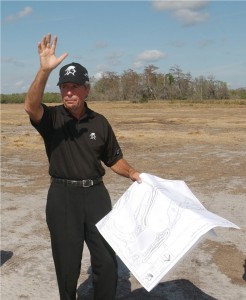Credit Where Credit’s Due
That some of the older golf courses sit at the top of the world course rankings is largely due to the labours of now highly celebrated golf course architects. The likes of Harry Colt and Alistair McKenzie, to name just a couple, are household names to any golf enthusiast. Their achievements are all the more remarkable when considering the equipment available to them in those bygone days.
In the ‘Harry Colt’ generation, the opportunity of creating artificial and expansive features simply wasn’t conceivable. No island greens, manufactured dunes, or artificially raised tees. Instead, they carved majestic layouts from what nature presented to them. That these courses have stood the test of time, and are still widely regarded amongst the best in the world, certainly vindicates their status in the pantheon of golf architecture.
 But times change, as do the tools and techniques on offer to the modern crop of designers. In this age of celebrity, it now seems that every new golf course needs a golfing legend lending their name to a ‘Signature Design’. Surely the likes of Colt and McKenzie were very ‘hands on’ in the implementation and construction of golf courses, but the modern generation of designers can’t devote the same time due to the extent of their commitments.
But times change, as do the tools and techniques on offer to the modern crop of designers. In this age of celebrity, it now seems that every new golf course needs a golfing legend lending their name to a ‘Signature Design’. Surely the likes of Colt and McKenzie were very ‘hands on’ in the implementation and construction of golf courses, but the modern generation of designers can’t devote the same time due to the extent of their commitments.
Jack Nicklaus, Gary Player, Greg Norman and Tom Weiskopf, the leading protagonists, are businessmen as well as legendary golfers. All have equipment lines, design projects, playing commitments, and numerous other developments under their corporate banner. Between them, they have several hundred courses bearing their names around the world. Simply by association, many of these courses are routinely named among the best in the world, but when you bear in mind how much time they can realistically dedicate to each project, it does make you wonder whether it should be solely their name assigned to each ‘Signature Course’.
You can understand why it’s done. A ‘Gary Player Signature Design’ rolls off the tongue more aesthetically than a ‘Player, Ferrell, Henegen, Lawrence, Lussier, & McFarlane Signature Design’ and the marketing value for the developers is huge. But while golfers may not be so excited at the prospect of playing the most recent Phil Smith, Mike Kenny, or Frank Henegen designed course, that’s exactly what we’re enjoying when we step foot on to the latest Tom Weiskopf, Ernie Els, or Gary Player signature layout. I wonder how many golfers have ever heard of these people, let alone know that they are the ones largely responsible for the layout of modern ‘Signature’ courses? I’m betting very few. The truth is we’re suckers for the showbiz name. And that one brand name attached to the course leaves us convinced that a player of Gary Player’s stature wouldn’t dare put his name to a course that was anything less than a masterpiece.
I’m not suggesting that designs by the likes of Gary Player or Greg Norman aren’t all they’re cracked up to be, far from it. In fact, (I can tell you from personal experience) Doonbeg, for example, deserves its status as one of the finest in the world. What I am suggesting, however, is that the behind-the-scenes designers deserve equal celebration. Here are the true geniuses at work.
Let’s face it, being a great golfer doesn’t automatically make you a great course designer – no more than the best mathematicians make the finest maths teachers. Without doubt, course design is an incredible skill in its own right. It’s fair to say that ex (or even current) pros will be able to draw on their experiences around the world and are certainly better placed than any old golfing schmuck with pencil and paper. But one doesn’t automatically follow the other. I guess it’s similar in the football world – it’s littered with failed ex-player managers who spoiled a great career with a dalliance in management. And, conversely, at the top of the tree, the likes of Arsene Wenger and José Mourinho weren’t great players but are great managers. One doesn’t automatically qualify you as the other but it won’t hurt. It’ll certainly give you the opportunity to try your hand!
I’m not saying we change the current format and plaster every golf course with multiple names accredited to the design. I’m just suggesting that when you see a ‘Signature Course’, the real signatures and geniuses at work are those of the design teams sitting modestly in the background. There are a few modern professional designers known and revered that didn’t make their names in the game beforehand – Pete Dye (TPC at Sawgrass, Kiawah Island, etc); Tom Doak (Pacific Dunes, Cape Kidnappers, etc) and Tom Fazio (Pinehurst No. 4 & 8, etc) – but it’s the non-celebrated ones doing the leg work I’m campaigning for! Perhaps in years to come, we should remember them alongside the likes of Colt and McKenzie.